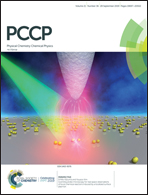Dynamics of AlOH inelastic scattering with p-H2(J = 0) on a full and accurate potential energy surface
Abstract
Alkali aluminum hydroxide, AlOH, has associated features with the chemistry of aluminum-bearing species and generally with metal hydroxide molecules in the interstellar clouds where it has been observed. The aim of this work is to obtain accurate rotational rate coefficients of AlOH colliding with the most abundant molecular species in the interstellar medium (ISM), H2, in its lowest rotational state p-H2(J = 0) for the kinetic temperature range 5–80 K. A full and accurate 4D-PES was generated using explicitly correlated coupled cluster with single, double and perturbative triple excitation CCSD(T)-F12a augmented by the aVTZ basis set. Both the close coupling CC and coupled states CS techniques were used to generate rotational cross-sections for AlOH-p-H2 including 13 rotational states (J1 = 0,…,12) for the AlOH molecule and the J2 = 0 state for the H2 molecule for energy thresholds up to E = 500 cm−1. Propensity rules that favor odd ΔJ1 transitions are found all over the temperature range. Further, a comparison of the present AlOH-p-H2(J = 0) rate coefficients with scaled AlOH–He rates was made, revealing mainly good agreement with some discrepancies appearing for large ΔJ1. The use of the present rates is viewed to be a good tool to estimate the aluminum hydroxide abundance.



 Please wait while we load your content...
Please wait while we load your content...